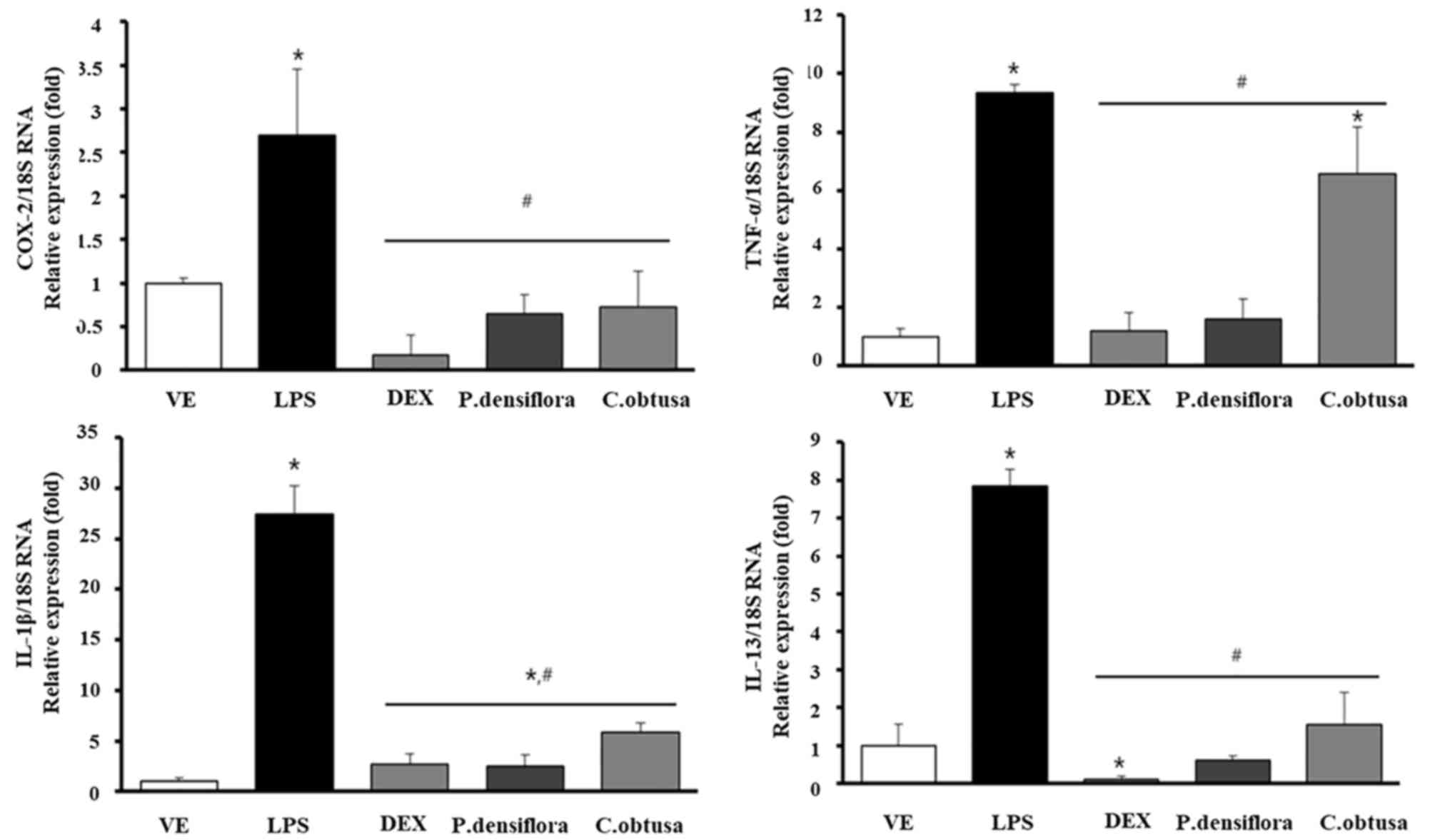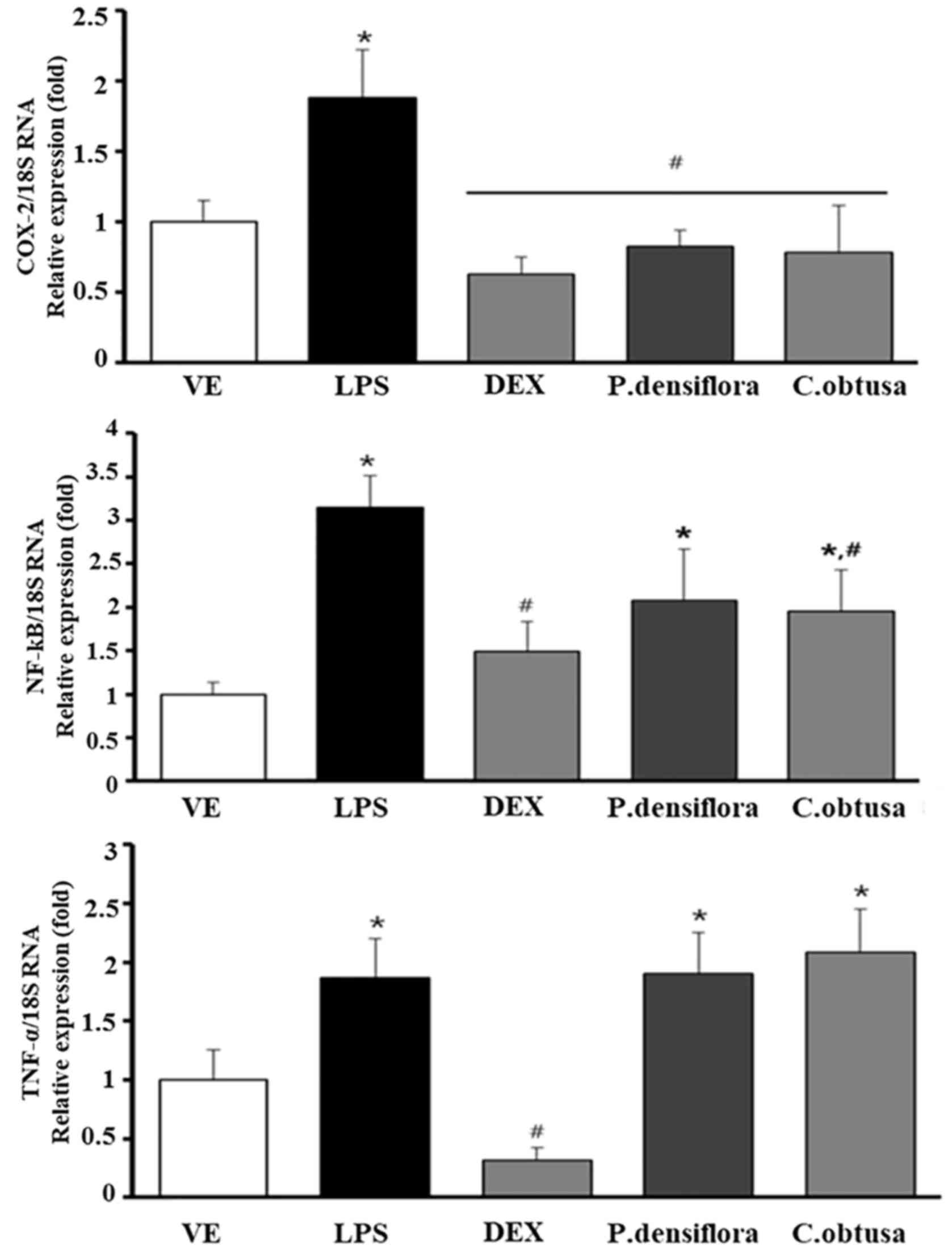|
1
|
Barnes PJ: Immunology of asthma and
chronic obstructive pulmonary disease. Nat Rev Immunol. 8:183–192.
2008. View
Article : Google Scholar : PubMed/NCBI
|
|
2
|
Beasley R, Roche WR, Roberts JA and
Holgate ST: Cellular events in the bronchi in mild asthma and after
bronchial provocation. Am Rev Respir Dis. 139:806–817. 1989.
View Article : Google Scholar : PubMed/NCBI
|
|
3
|
Holgate S, Casale T, Wenzel S, Bousquet J,
Deniz Y and Reisner C: The anti-inflammatory effects of omalizumab
confirm the central role of IgE in allergic inflammation. J Allergy
Clin Immunol. 115:459–465. 2005. View Article : Google Scholar : PubMed/NCBI
|
|
4
|
Nakashima T, Hayashi T and Mizuno T:
Regulation of the development of asthmatic inflammation by in situ
CD4(+)Foxp3 (+) T cells in a mouse model of late allergic asthma.
Inflammation. 37:1642–1653. 2014. View Article : Google Scholar : PubMed/NCBI
|
|
5
|
McConnell HM, Watts TH, Weis RM and Brian
AA: Supported planar membranes in studies of cell-cell recognition
in the immune system. Biochim Biophys Acta. 864:95–106. 1986.
View Article : Google Scholar : PubMed/NCBI
|
|
6
|
Galli SJ, Tsai M and Piliponsky AM: The
development of allergic inflammation. Nature. 454:445–454. 2008.
View Article : Google Scholar : PubMed/NCBI
|
|
7
|
Yang H, Ahn C, Choi IG, Choi WS, Park MJ,
Lee SS, Choi DH and Jeung EB: Estimation of the environmental
effect of natural volatile organic compounds from Chamaecyparis
obtusa and their effect on atopic dermatitis-like skin lesions in
mice. Mol Med Rep. 12:345–350. 2015. View Article : Google Scholar : PubMed/NCBI
|
|
8
|
Joo SS, Yoo YM, Ko SH, Choi W, Park MJ,
Kang HY, Choi KC, Choi IG and Jeung EB: Effects of essential oil
from Chamaecyparis obtusa on the development of atopic
dermatitis-like skin lesions and the suppression of Th cytokines. J
Dermatol Sci. 60:122–125. 2010. View Article : Google Scholar : PubMed/NCBI
|
|
9
|
An BS, Kang JH, Yang H, Jung EM, Kang HS,
Choi IG, Park MJ and Jeung EB: Anti-inflammatory effects of
essential oils from Chamaecyparis obtusa via the cyclooxygenase-2
pathway in rats. Mol Med Rep. 8:255–259. 2013. View Article : Google Scholar : PubMed/NCBI
|
|
10
|
Yang H, Jung EM, Ahn C, Lee GS, Lee SY,
Kim SH, Choi IG, Park MJ, Lee SS, Choi DH, et al: Elemol from
Chamaecyparis obtusa ameliorates 2,4-dinitrochlorobenzene-induced
atopic dermatitis. Int J Mol Med. 36:463–472. 2015. View Article : Google Scholar : PubMed/NCBI
|
|
11
|
Almeida JR, Souza GR, Silva JC, Saraiva
SR, Júnior RG, Quintans JS, Barreto RS, Bonjardim LR, Cavalcanti SC
and Quintans LJ Jr: Borneol, a bicyclic monoterpene alcohol,
reduces nociceptive behavior and inflammatory response in mice. Sci
World J. 2013:8084602013. View Article : Google Scholar
|
|
12
|
Miguel MG: Antioxidant and
anti-inflammatory activities of essential oils: A short review.
Molecules. 15:9252–9287. 2010. View Article : Google Scholar : PubMed/NCBI
|
|
13
|
Ince I, Yesil-Celiktas O,
Karabay-Yavasoglu NU and Elgin G: Effects of Pinus brutia bark
extract and Pycnogenol in a rat model of carrageenan induced
inflammation. Phytomedicine. 16:1101–1104. 2009. View Article : Google Scholar : PubMed/NCBI
|
|
14
|
Choi EM: Antinociceptive and
antiinflammatory activities of pine (Pinus densiflora) pollen
extract. Phytother Res. 21:471–475. 2007. View Article : Google Scholar : PubMed/NCBI
|
|
15
|
Rumchev K, Spickett J, Bulsara M, Phillips
M and Stick S: Association of domestic exposure to volatile organic
compounds with asthma in young children. Thorax. 59:746–751. 2004.
View Article : Google Scholar : PubMed/NCBI
|
|
16
|
Shi Y, Zhang P, Zhang L, Osman H, Mohler
ER III, Macphee C, Zalewski A, Postle A and Wilensky RL: Role of
lipoprotein-associated phospholipase A2 in leukocyte activation and
inflammatory responses. Atherosclerosis. 191:54–62. 2007.
View Article : Google Scholar : PubMed/NCBI
|
|
17
|
Jung EM, An BS, Choi KC and Jeung EB:
Apoptosis- and endoplasmic reticulum stress-related genes were
regulated by estrogen and progesterone in the uteri of
calbindin-D(9k) and -D(28k) knockout mice. J Cell Biochem.
113:194–203. 2012. View Article : Google Scholar : PubMed/NCBI
|
|
18
|
Boguniewicz M and Leung DY: Atopic
dermatitis: A disease of altered skin barrier and immune
dysregulation. Immunol Rev. 242:233–246. 2011. View Article : Google Scholar : PubMed/NCBI
|
|
19
|
Gebben HJ: Topical immunomodulators, such
as tacrolimus and pimecrolimus, in the treatment of atopic
dermatitis. Ned Tijdschr Geneeskd. 149:1816–1817. 2005.(In Dutch).
PubMed/NCBI
|
|
20
|
Dharmage SC, Lowe AJ, Matheson MC, Burgess
JA, Allen KJ and Abramson MJ: Atopic dermatitis and the atopic
march revisited. Allergy. 69:17–27. 2014. View Article : Google Scholar : PubMed/NCBI
|
|
21
|
Dereure O, Bessis D, Guillot B and Guilhou
JJ: Treatment of bullous pemphigoid by low-dose methotrexate
associated with short-term potent topical steroids: An open
prospective study of 18 cases. Arch Dermatol. 138:1255–1256. 2002.
View Article : Google Scholar : PubMed/NCBI
|
|
22
|
Abramovits W: Atopic dermatitis. J Am Acad
Dermatol. 53 Suppl 1:S86–S93. 2005. View Article : Google Scholar : PubMed/NCBI
|
|
23
|
Surh YJ, Na HK, Lee JY and Keum YS:
Molecular mechanisms underlying anti-tumor promoting activities of
heat-processed Panax ginseng C.A. Meyer. J Korean Med Sci.
16:S38–S41. 2001. View Article : Google Scholar : PubMed/NCBI
|
|
24
|
Elfawal MA, Towler MJ, Reich NG, Weathers
PJ and Rich SM: Dried whole-plant Artemisia annua slows evolution
of malaria drug resistance and overcomes resistance to artemisinin.
Proc Natl Acad Sci USA. 112:821–826. 2015. View Article : Google Scholar : PubMed/NCBI
|
|
25
|
Kawai M, Hirano T, Higa S, Arimitsu J,
Maruta M, Kuwahara Y, Ohkawara T, Hagihara K, Yamadori T, Shima Y,
et al: Flavonoids and related compounds as anti-allergic
substances. Allergol Int. 56:113–123. 2007. View Article : Google Scholar : PubMed/NCBI
|
|
26
|
Tan HY, Zhang AL, Chen D, Xue CC and Lenon
GB: Chinese herbal medicine for atopic dermatitis: A systematic
review. J Am Acad Dermatol. 69:295–304. 2013. View Article : Google Scholar : PubMed/NCBI
|
|
27
|
Jang HWKM and Lee KG: Antioxidant activity
and characterization of volatile extracts of Capsicum annuum L. and
Allium spp. Flavour Fragrance J. 23:178–184. 2008. View Article : Google Scholar
|
|
28
|
Wang W, Zhou Q, Liu L and Zou K:
Anti-allergic activity of emodin on IgE-mediated activation in
RBL-2H3 cells. Pharmacol Rep. 64:1216–1222. 2012. View Article : Google Scholar : PubMed/NCBI
|
|
29
|
Vender RB: Alternative treatments for
atopic dermatitis: A selected review. Skin Therapy Lett. 7:1–5.
2002.PubMed/NCBI
|
|
30
|
Park D, Jeon JH, Kwon SC, Shin S, Jang JY,
Jeong HS, Lee DI, Kim YB and Joo SS: Antioxidative activities of
white rose flower extract and pharmaceutical advantages of its
hexane fraction via free radical scavenging effects. Biochem Cell
Biol. 87:943–952. 2009. View Article : Google Scholar : PubMed/NCBI
|
|
31
|
Heinzel FP, Sadick MD, Holaday BJ, Coffman
RL and Locksley RM: Reciprocal expression of interferon gamma or
interleukin 4 during the resolution or progression of murine
leishmaniasis. Evidence for expansion of distinct helper T cell
subsets. J Exp Med. 169:59–72. 1989. View Article : Google Scholar : PubMed/NCBI
|
|
32
|
Lyss G, Knorre A, Schmidt TJ, Pahl HL and
Merfort I: The anti-inflammatory sesquiterpene lactone helenalin
inhibits the transcription factor NF-kappaB by directly targeting
p65. J Biol Chem. 273:33508–33516. 1998. View Article : Google Scholar : PubMed/NCBI
|
|
33
|
Paduch R, Kandefer-Szerszeń M, Trytek M
and Fiedurek J: Terpenes: Substances useful in human healthcare.
Arch Immunol Ther Exp (Warsz). 55:315–327. 2007. View Article : Google Scholar : PubMed/NCBI
|
|
34
|
de Cássia da Silveira e Sá R, Andrade LN
and de Sousa DP: A review on anti-inflammatory activity of
monoterpenes. Molecules. 18:1227–1254. 2013. View Article : Google Scholar : PubMed/NCBI
|














